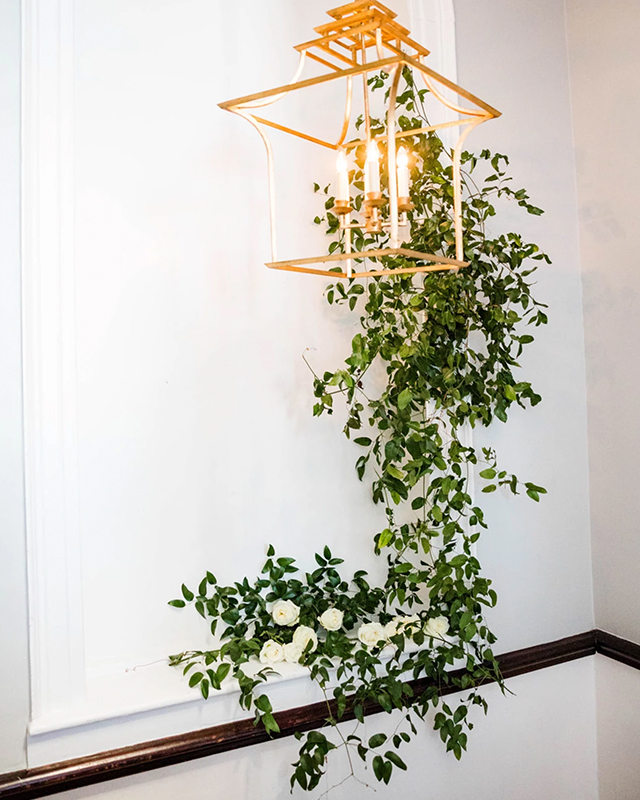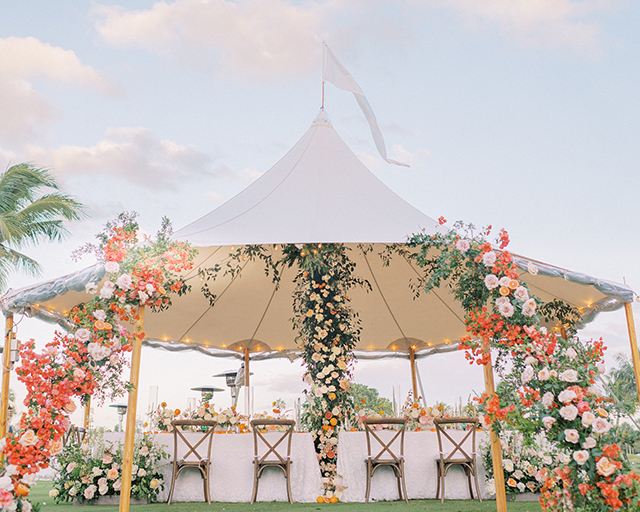The Keys to Creating Inventive and Event-Ready Florals
Florals can enhance any gathering, whether you’re hosting an intimate celebration or large-scale affair. With wedding season approaching, we reached out to six floral experts across the country to find out their secrets and strategies to creating arrangements that add elegance, sophistication, and personality to an event. Here, they share everything from how to use florals to set a specific mood to ways to achieve a naturally foraged feel to opportunities to dress up often overlooked areas and more. To find a floral designer in your area, consult The Scout Guide directory here.
 Tablescape design by Blossoms Creative. Photography by Anastasiia Photography.
Tablescape design by Blossoms Creative. Photography by Anastasiia Photography.
Consider the mood. A good place to start when creating a tablescape is to consider the mood you want your guests to experience, says Adrienne Kort, owner of Blossoms Creative in Asheville, North Carolina. For example, when a client wanted to create an intimate and natural indoor setting for their wedding guests, she and her team had brainstorming sessions with them about the ultimate overall look and feel of the event. The result is the lush tablescape above, which had an element of fanciness but still felt laid-back—a combination that was carried through into the table settings and food served.
Remember that visibility is key. When designing for a seated dinner, you want to ensure that guests will easily be able to enjoy conversation, without an arrangement inhibiting eye contact. Because Kort’s clients sought a grand display, she chose taller pieces to ensure visibility across the table. Not only did this allow guests to see eye-to-eye, but it also helped create a more intimate atmosphere but visually lowering the ceiling height. At table level, she kept things interesting by adding votives that come sunset, danced off of the crystal and brass silverware.
 Photography courtesy of Philo Floral.
Photography courtesy of Philo Floral.
Utilize the natural landscape around you. It’s a misconception that you have to use fresh greenery in your arrangements, Elizabeth Hodges, owner and lead designer at Philo Floral in Greenville, South Carolina, asserts. “Incorporating foraged elements from around the area, dried products, and fresh florals helps form the base for a natural, organic shape,” she explains, noting that this also gives arrangements a familiar, hyper-local feel. For the large hanging arrangement depicted above, she utilized trees that were in the transitions of seasons, dried leaves, twigs, and even mosses, creating a beautiful, nature-inspired focal point.
Create continuity. Flower arranging is a wildly creative endeavor, and there are many different styles and ways to approach each arrangement. One of Hodges key principles in the way she creates her arrangements is to mass colors together. “I love to use tones that work well together, like blues and purple or pinks and blushes,” she explains. “Doing this helps the eye ‘rest’ on areas of the design and not jump around.” In a similar concept to color blocking, Hodges often pairs like flowers together in a cluster to help with the overall ease and feel of a design. Additionally, she notes that this is a fantastic way to elevate store bought flowers when creating arrangements at home.
Don’t be afraid of negative space. Florals don’t have to be compact and busy, Hodges points out. In fact, allowing them room to breathe adds an element of natural playfulness to your arrangements. “I once had a bride’s mother tell me that her grandmother thought a butterfly should be able to fly in and around the whole design of the arrangement, just like in nature,” she says. “That’s an excellent way to visualize creating an arrangement, allowing all of the elements some space to spread out and breathe.”
 Photography courtesy of Pigmint Floral Studio.
Photography courtesy of Pigmint Floral Studio.
Incorporate live plants. Utilizing live plants or topiaries is a great way to evoke a fresh, sophisticated aesthetic at an event. Case in point: Chelsea Hermez, owner of Pigmint Floral Studio in Fayetteville, Arkansas, used an overgrown French formal garden as her inspiration for the above tablescape, incorporating miniature versions of living topiaries interspersed with potted herbs with luscious dark green veins to tie it all together. Plus, “Living plants make great take-away gifts, or they could even be used in the couple’s home or garden after the wedding,” Hermez says. She adds that some local florists rent live plants, making it a potentially more affordable centerpiece option over cut flowers (or, if you have a green thumb, you could pot up your own plants). We always recommend enlisting an expert, but if you try to achieve this look on your own, she recommends paying attention to the top dressing of the plant (Spanish moss was utilized in her design) and inserting saucers under planters to protect your table linens.
Let your centerpiece shine. If you’re aiming for a look like the one above, Hermez recommends keeping the supporting elements simple so your centerpiece doesn’t compete. To ensure that the potted greens in the tablescape were the star feature, she chose classic neutral linens and glassware.
 Installation by Marigold Floral Studio. Photography courtesy of Marigold Floral Studio.
Installation by Marigold Floral Studio. Photography courtesy of Marigold Floral Studio.
Don’t forget the “in-between” places at your venue. Bri Roberts, owner of Marigold Floral Studio in Charleston, South Carolina, likes to look beyond traditional centerpieces and dress hallways and walkways in greenery. “You don’t need to go overboard with florals,” she notes. “You can add interest with greenery or candles.” These special touches make for a memorable and enchanting evening.
Embrace architecture. When a venue has significant historical charm or architectural interest, Roberts likes to let those features take center stage and have floral installations be a natural complement. For example, she’ll often add vines and local greenery to “grow” or climb along corners and alcoves, mimicking an unkempt garden. “Clear fishing wire and clear command hooks are staples in my florist tool bag,” she shares.
 Installation by The Wandering Petal. Photography by Elizabeth Friske Bargy.
Installation by The Wandering Petal. Photography by Elizabeth Friske Bargy.
Know the power of a wow factor. It’s hard to deny the impact of one show-stopping installment. Nicole Turkenkoph, owner of The Wandering Petal in Virginia Beach, Virginia, created a stunning floral installment when the understated, classic bride shared her adoration for tulips. Fashioning a show-stopper over the head table in the reception tent required significant coordination, from meetings with a lighting and production company to build the base structure to a team of six florists and 20 man hours to individually wire 1,500 tulips, but the end result was nothing short of breathtaking. While creating an installation like this is an undertaking, it has the power to create a magical environment, transporting guests to a land of wonder and whimsy.
 Installation by Kaleidoscope Floral. Photography by Matt Rice.
Installation by Kaleidoscope Floral. Photography by Matt Rice.
Think outside the tent. Outdoor weddings come with their very own built-in natural splendor, but Sean Stevenson, co-owner of Kaleidoscope Floral in Naples, Florida, finds they can also be the perfect canvas for the unexpected. For example, inspired by old Florida and the charm of Boca Grande, he created a natural overgrown tent entrance with a mixture of bougainvillea, naturally grown around the island, with a mix of local greenery and more transitional wedding flowers. To add a cohesiveness to the look, the tablescapes, as well as the center pole of the tent, were designed with a variety of bright and sunset-hued flowers, as well as a mix of local citrus in and around the arrangements that added interest. More is more indeed.




